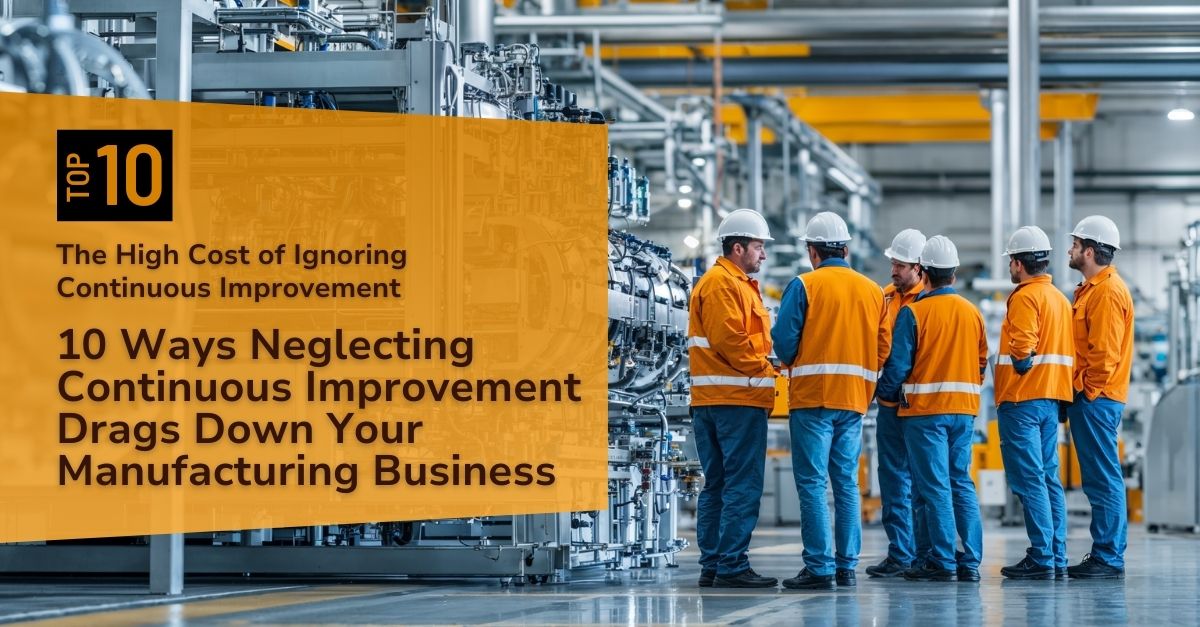
In today’s manufacturing environment, compliance and safety aren’t just about checking boxes or passing audits; they’re foundational to protecting your workforce, safeguarding operations, and maintaining customer trust.
But without a strong, fully integrated Management Operating System (MOS), even the most well-intentioned safety and compliance efforts fall apart.
When that structure is missing, or not functioning as intended, compliance and safety don’t just suffer. They become a liability.
Below are 10 high-cost consequences manufacturers face when the MOS isn’t doing its job to support compliance and safety.
1Increased Legal Liabilities:
When compliance responsibilities aren’t built into everyday workflows, violations are almost inevitable. From missed reporting deadlines to overlooked inspections, the result is often legal action, government fines, or costly settlements. For example, OSHA violations can cost over $15,000 per incident, with willful or repeated offenses exceeding $150,000. These costs add up fast, especially when the same gaps go unresolved. A weak MOS allows these gaps to persist because no one is clearly accountable for closing them.
2Elevated Safety Incidents:
Without strong MOS processes to capture near-misses, track hazards, and reinforce safe work practices, injuries rise, and so do the hidden costs. According to the National Safety Council, the average total cost of a workplace injury is over $40,000. But that figure doesn’t include the impact on morale, downtime, or the long-term loss of an experienced team member. When safety isn’t part of the daily rhythm of the operation, accidents become more frequent, and preventable risk becomes normalized.
3Heightened Regulatory Scrutiny:
Fail one inspection, and you’ll likely be dealing with follow-ups for months. Repeat issues signal to regulators that you lack internal controls, which means more site visits, more documentation requirements, and tighter oversight. Without an MOS that tracks corrective actions, assigns ownership, and verifies closure, your operation stays stuck in audit mode. Teams spend more time responding to regulators than running the business, creating an ongoing drag on productivity.
4Disruption in Supply Chain:
Compliance failures don’t stay contained, they cascade. Whether it’s a rejected shipment, a withheld certification, or a sudden work stoppage, delays caused by non-compliance reverberate through your supply chain. Customers waiting on parts may cancel orders or shift to more reliable suppliers. A sound MOS ensures that compliance checks are built into key handoffs, before they become roadblocks that slow down production and damage partnerships.
5Impact on Employee Morale and Productivity:
Workers notice when leadership turns a blind eye to unsafe conditions or fails to follow through on compliance expectations. The result is disengagement, slowdowns, and in some cases, open resistance. A strong MOS reinforces safety and compliance through structure: daily check-ins, standardized processes, clear escalation paths, and active supervisor involvement. When that structure is missing, teams begin to operate in survival mode, and performance suffers across the board.
6Barriers to Market Access:
In regulated industries like food, pharma, aerospace, or automotive, non-compliance doesn’t just get you fined, it gets you shut out. Even in less regulated sectors, missing documentation or poor audit performance can disqualify you from bidding on contracts or expanding into new regions. A well-implemented MOS doesn’t just help you stay compliant, it generates the documentation, audit trails, and process controls that make your business credible to buyers and certifiers alike.
7Increased Insurance Costs:
Insurance premiums are based on risk. When insurers see a pattern of safety violations, unclosed incidents, or weak documentation, they charge accordingly, or walk away. Premium increases of 20–30% aren’t uncommon for operations with spotty compliance histories. An effective MOS helps mitigate this risk by ensuring safety policies are implemented consistently, inspections are logged and acted on, and performance data is transparent, giving insurers confidence and lowering your overall exposure.
8Resource Drain in Managing Compliance Issues:
When a compliance or safety problem arises, most teams shift into reactive mode: pulling people from their regular roles, diverting capital to quick fixes, and racing to patch things up for auditors or inspectors. These scrambles are expensive, time-consuming, and completely avoidable with a strong MOS. Instead of playing whack-a-mole with problems, a solid system allows you to anticipate risks, assign ownership early, and track resolution before issues spiral out of control.
9Compromised Product Quality and Consistency:
Regulatory compliance often ties directly into product standards. A missing temperature check, an outdated calibration, or a skipped inspection might be a compliance issue on paper, but it also impacts what goes out the door. Customers experience defects. Complaints rise. Rework eats up capacity. Without a reliable MOS to reinforce quality checkpoints and provide line-of-sight into day-to-day execution, you’re more likely to ship product that doesn’t meet your own standards, let alone the customer’s.
10Hindered Innovation and Growth:
Every hour and dollar spent dealing with compliance fires is an hour and dollar not spent improving your operation. When leadership is stuck in a cycle of damage control, there’s no bandwidth for innovation, capability development, or strategic expansion. A robust MOS creates space to grow, by reducing fire drills, standardizing execution, and keeping your organization focused on what moves the business forward, not just what keeps it afloat.
Conclusions for Manufacturing Operations Leaders
As we explore the vital significance of compliance and safety risks in manufacturing operations, the undeniable importance of a robust Management Operating System (MOS) comes into sharp focus.
The consequences of overlooking compliance and safety are far-reaching, impacting not just the operational aspects but also the foundation of a manufacturer’s credibility and sustainability.
For manufacturing leaders, addressing these risks is not merely about meeting regulatory requirements; it’s about strategically embedding compliance and safety into the core of their operations.
Doing so protects the company from legal and financial repercussions and enhances overall operational integrity, employee safety, and market competitiveness.
Maximize Compliance and Safety with POWERS
At POWERS, we specialize in tackling the intricate challenges of systems, processes, and behaviors in today’s multifaceted manufacturing environments.
Our expertise, grounded in real-world experiences, is centered on strengthening Management Operating Systems to manage compliance and safety risks effectively.
- Customized Compliance Solutions: We craft tailored strategies that align with each manufacturing operation's needs, focusing on practical MOS solutions that reinforce compliance and safety.
- Digital Production System (DPS) Integration Our DPS platform makes safety and compliance visible, measurable, and trackable. Real-time dashboards, alerts, and performance trends give your team immediate feedback and accountability.
- Comprehensive Approach: Our methodology extends beyond technical MOS aspects, emphasizing leadership, employee safety training, and a culture of compliance and continuous improvement.
- Innovative Risk Management: We integrate innovative approaches to risk management, ensuring proactive identification and mitigation of potential compliance and safety issues.
- Strategic Regulatory Alignment: Our team stays abreast of regulatory changes, aligning strategies to ensure clients are compliant and ahead of industry standards.
Start your journey towards excellence in compliance, safety, and operational efficiency with POWERS. Contact our expert team at +1 678-971-4711 or via email at info@thepowerscompany.com.
Continue Reading from this Mastery Series
- Part 1 - Identifying Key Inefficiencies in the Absence of a Management Operating System
- Part 2 - Top 10 Pitfalls: Lack of an MOS Derails Productivity
- Part 3 - Top 10 Quality Issues at Risk Without a Robust Management Operating System
- Part 4 - The High Cost of an Ineffective Management Operating System
- Part 5 - Without an Optimized Management Operating System, Decision-Making is Severely Impaired
- Part 6 - Scaling Challenges of an Inadequate Management Operating System
- Part 7 - The High Price of Low Engagement: Unpacking the Operational Impact of Employee Discontent
- Part 8 - Safeguarding Success: Decoding the Impact of Compliance and Safety Issues
- Part 9 - Examining the Cost of a Slow Response to Market Shifts
- Part 10 - Charting Success: Understanding the Costs of Losing Competitive Advantage







